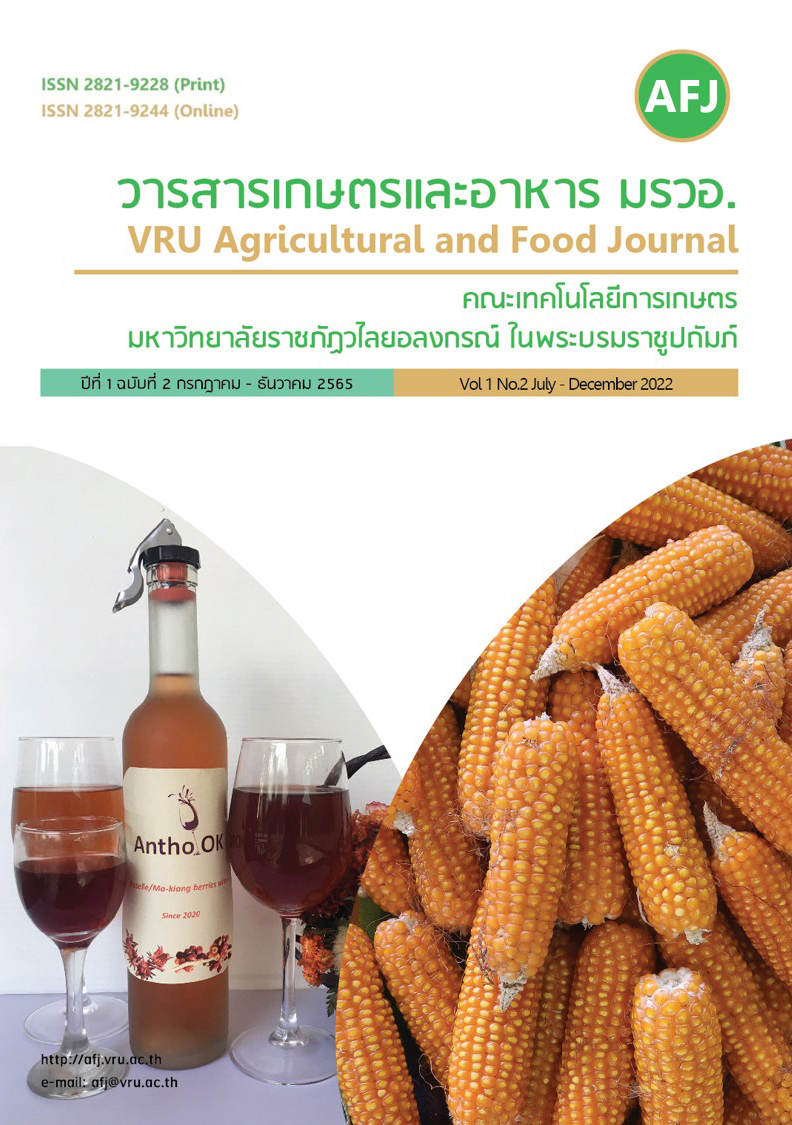Effect of Endophytic Bacteria on Growth of Indigo Plants
Main Article Content
Abstract
Endophytic bacteria are the important factors in natural system to produce many bioactive compounds which are promoting growth efficiency. This research was carried out isolating of bacteria from roots 3 indigo plants in Phrae province consist of Strobilanthes cusia, Baphicacanthus cusia voucher and Strobilanthes auriculata voucher. Four isolates of bacteria were obtained but found three isolates which are endophyte bacterial qualify, especially isolated Sc-WH01 is the highest to fix Nitrogen, synthesize IAA and solubilize phosphate. Using of 16S rRNA gene sequence based methods showing the Sc-WH01 relationship of Pseudoxanthomonas spadix, >98 percent similarly. The result of Sc-WH01 Endophyte bacterial capability to against plant disease showed that it was able to inhibit Rhizoctonia solani and Sclerotium rolfsii which caused roots rot disease by assessing from zone of inhibition areas equal to 0.53 and 0.45 centimeters, respectively. And the result of growth performance of Indigo plants. It was found S. cusia, B. cusia voucher and S. auriculata voucher planting with 60 CFU/ml for 80 days can be best promoting growth performance. Height efficiency increased by 3.00, 3.30 and 1.20 centimeters, respectively. Also, root length efficiency increased by 2.60, 3.00 and especially, leaf number increased by 76.60, 14.00 and 24.00 leaves, respectively. By mean of statistically significant difference (P<0.05). Therefore, it is appropriate to use for promoting growth performance of indigo plants
Article Details

This work is licensed under a Creative Commons Attribution-NonCommercial-NoDerivatives 4.0 International License.
This article is published under a Creative Commons Attribution-NonCommercial-NoDerivatives 4.0 International License (CC BY-NC-ND 4.0), which allows others to share the article with proper attribution to the authors and prohibits commercial use or modification. For any other reuse or republication, permission from the journal and the authors is required.References
Ahmad, F., I. Ahma and M.S. Khan. 2006. Screening of free-living rhizospheric bacteria for their multiple plant growth promoting activities. Microbiol Research. 163 – (2): 173 – 181.
Andreolli, M., L. Silvia, Z. Giacomo, A. Elisa and V. Giovanni. 2016. Diversity of bacterial endophytes in 3 and 15 year–old grapevines of Vitis vinifera cv. Corvina and their potential for plant growth promotion and phytopathogen control. Microbial Research. 183: 42 – 52.
Chanchay, N. 2021a. Endophytic bacteria (Terriglobus saanensis MJUP06) on germination of Phak Wan Pa (Melientha suavis Pierre.). Sci. Tech. Nakhon Sawan Raj. Uni. J. 13(17): 1 – 11.
Chanchay, N. 2021b. Hom’s Phrae: The wisdom and innovation for sustainable developing. 1st ed. Smart Coating and Service Co., Ltd., Chiangmai. (in Thai)
Chebotar, V.K., N.V. Malfanova, A.V. Shcherbakov, G.A. Ahtemova, A.Y. Borisov, B. Lugtenberg and I.A. Tikhonovich. 2015. Endophytic bacteria in microbial preparations that improve plant development. Biochemistry and Microbiology. 51: 271 – 277.
Dilfuza, E., J. W. Stephan, V.S. Vyacheslav, H. Abeer and F.A. Elsayed. 2017. Endophytic bacteria improve plant growth, symbiotic performance of chickpea (Cicer arietinum L.) and induce suppression of root rot caused by Fusarium solani under salt stress. Frontiers in Microbiology. 8: 1887.
Huda, N., T. Rabia, B. Javaria, A. Iftikhar and R. Yasir. 2022. Arsenic–Resistant Plant Growth Promoting Pseudoxanthomonas Mexicana S254 and Stenotrophomonas maltophilia S255 Isolated from Agriculture Soil Contaminated by Industrial Effluent. Sustainability. 10697.
Jumpathong, J. and K. Masin. 2018. Screening for Biological Activities of Bacteria Isolated from Agricultural Soil in Central Area. Science and Technology Nakhon Sawan Rajabhat University Journal, 10(11): 59 – 74. (in Thai)
Pallab, K.G., S. Pradipta, M. Shanmugam and K.M. Tushar. 2013. Role of IAA metabolizing enzymes on production of IAA in root, nodule of Cajanus cajan and its PGP Rhizobium sp. Biocatalysis and Agricultural Biotechnology. 2: 234 – 239.
Suphan, S., P. Prajankett and S. Pongswat. 2016. Using nitrogen fixing bacteria with biological supporting media for promoting the plant growth. Sci. & Tech. RMUTT J. 6(2): 17 – 28.
Zhang, H., Y. Zhang and M. Wei. 2010. Comparative Analysis of Climatic Factors between Libo County and Strobilanthes cusia (Nees) O. Kuntze Growth. Medicinal Plant, 1(9): 9 – 11


